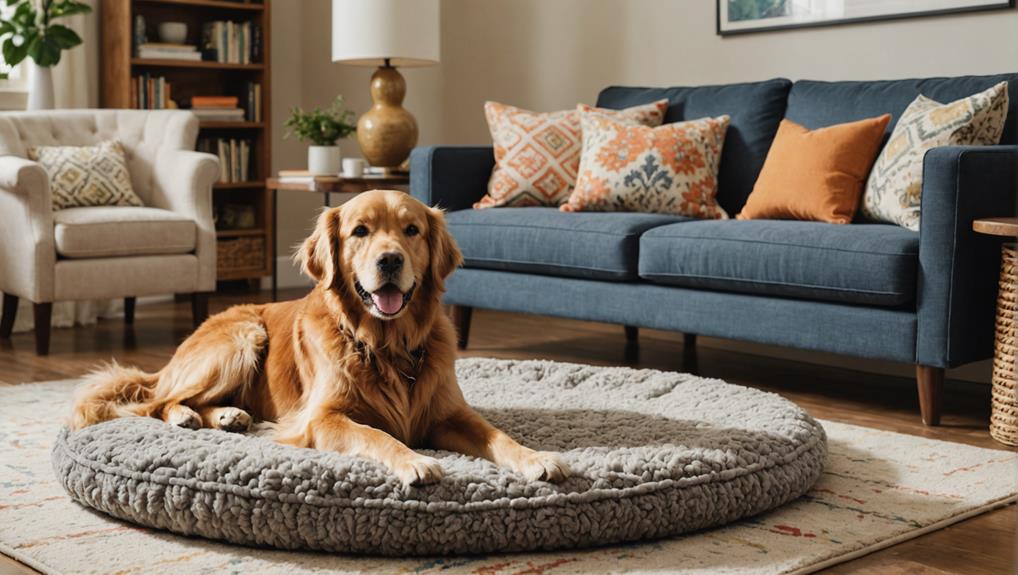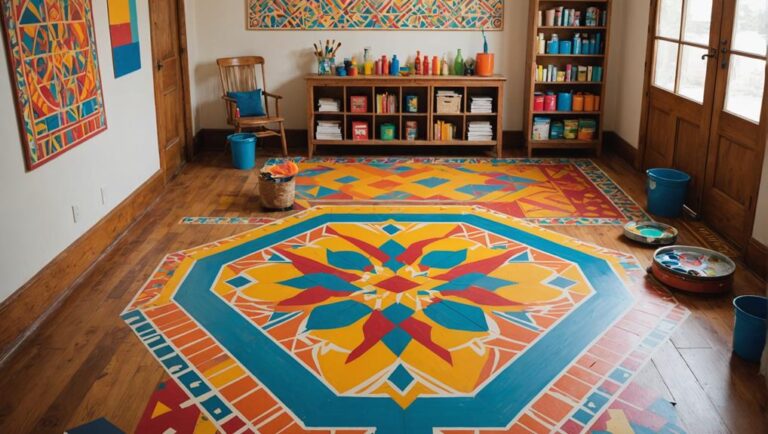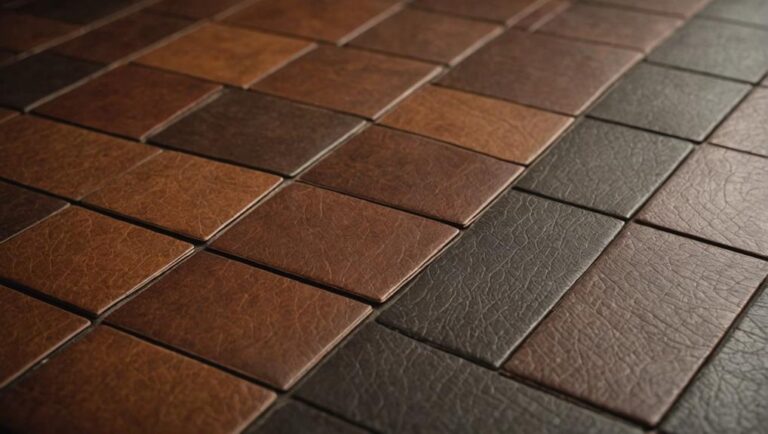When selecting flooring for older pets, you'll want to prioritize safety and comfort. Soft, cushioned surfaces, like orthopedic carpets and high-density foam mats, help reduce joint strain. Slip-resistant options such as textured vinyl and rubber mats enhance grip, minimizing the chances of slips and falls. Consider low-pile carpet tiles for easy maintenance and safety, or stain-resistant tiles that simplify cleaning. Non-slip backed area rugs can also provide stability while adding style. By creating a secure environment, you'll help your furry friend feel more at ease as they move around. Keep exploring to find even more tailored flooring solutions for their needs.
Importance of Pet Safety Flooring
When it comes to creating a safe environment for your pets, choosing the right flooring is essential. The floor texture can greatly impact your pet's mobility, especially for older dogs and cats who may struggle with balance and stability. Hard surfaces like tile or hardwood can be unforgiving, leading to slips and falls that pose serious risks to your furry friends.
A soft, textured floor can provide a better grip for your pets, making it easier for them to navigate your home. Consider materials like carpet or area rugs that offer cushioning and traction. These surfaces can help prevent injuries and make your pet feel more secure as they move around. Additionally, if your pet has arthritis or other mobility issues, softer flooring can reduce strain on their joints, allowing them to move more comfortably.
It's also important to think about how easy the flooring is to clean. Pets can be unpredictable when it comes to accidents, so selecting materials that are both safe and low-maintenance is vital. Look for options that are stain-resistant and easy to wipe down, ensuring your home remains hygienic for both you and your pets.
Ultimately, investing in the right flooring is a proactive step toward enhancing your pet's quality of life. By prioritizing their safety and comfort, you create a loving environment where they can thrive, regardless of their age or mobility challenges.
Slip-Resistant Flooring Options
While choosing flooring for your home, you'll want to contemplate slip-resistant options that provide both safety and comfort for your pets. Older pets can struggle with mobility, making it essential to select surfaces that minimize the risk of slipping. One effective solution is to incorporate rubber mats in high-traffic areas. These mats offer excellent traction and cushioning, which can help prevent slips and falls, especially for pets with joint issues or balance concerns.
Textured tiles are another fantastic choice for slip-resistant flooring. They come in various styles and materials, such as porcelain or vinyl, and their raised patterns enhance grip. This makes it easier for your pets to navigate your home without the fear of skidding across the floor. When looking for textured tiles, consider options that are specifically designed for wet areas, as they tend to have even better slip resistance.
It's also worth noting that some flooring materials, like laminate or hardwood, can be slippery when wet. If you already have these types of floors, placing rubber mats strategically can notably improve safety. Additionally, be sure to regularly clean your floors to remove any potential hazards like pet hair or spills that could increase slipping risks.
Soft and Cushioned Surfaces
For pet owners, choosing soft and cushioned surfaces can greatly enhance both comfort and safety in your home. As your pets age, they might experience joint pain or mobility issues, and providing them with a supportive environment is essential. Cushioned mats and orthopedic carpets can make a significant difference in their daily lives, offering a soft landing for their paws while also reducing the risk of slips and falls.
Cushioned mats are particularly beneficial in areas where your pets spend most of their time, such as near their beds or favorite resting spots. These mats provide a warm, stable surface that eases the strain on aging joints and muscles. Look for mats made from high-density foam or gel-infused materials, which can help distribute weight evenly and provide ideal support.
Orthopedic carpets are another excellent choice for pet-friendly homes. These carpets are designed with extra padding and cushioning, creating a plush surface that pets will love. When selecting orthopedic carpets, consider those with stain-resistant and easy-to-clean features, as accidents can happen.
It's important to remember that the right flooring not only enhances comfort but also minimizes the risk of injury. Soft and cushioned surfaces can help your older pets navigate your home with ease, promoting a sense of security. By investing in these thoughtful flooring options, you're taking a proactive step in ensuring your furry companions feel safe and comfortable as they age.
Best Flooring Materials for Seniors
Choosing the right flooring materials can greatly impact the safety and comfort of seniors living in your home. When considering options, you want to prioritize both pet mobility and flooring durability. Here are four excellent choices:
- Vinyl Flooring: This material is not only durable but also water-resistant, making it a great choice for homes with pets. It offers a non-slip surface that can help prevent falls.
- Laminate Flooring: Laminate is known for its scratch resistance and ease of maintenance. Its hard surface can provide stability, but verify it has a textured finish to enhance grip.
- Cork Flooring: Cork is soft underfoot, which can be gentle on joints, and it's naturally slip-resistant. Plus, it's eco-friendly and has sound-dampening qualities, creating a quieter environment for both seniors and pets.
- Carpet Tiles: These are versatile and can be replaced individually if damaged. Choose low-pile options for easier mobility and minimal tripping hazards, while also providing comfort.
When selecting flooring materials, consider the unique needs of your seniors. Opt for surfaces that not only enhance safety but also offer comfort and warmth. With the right choices, you can create an environment that supports their mobility and provides peace of mind for everyone in the household. Always remember that a safe home is a happy home, especially for those who need a little extra care.
Area Rugs and Safety Mats
Area rugs and safety mats can play an essential role in enhancing the safety of your home, especially when pets and seniors are involved. Choosing the right area rug types and strategically placing mats can create a safer environment, reducing the risk of slips and falls.
When selecting area rugs, consider non-slip backing options. These rugs help keep the rug securely in place, providing stability for your older pets and family members. Additionally, opt for low-profile designs to minimize tripping hazards. Safety mats, particularly in high-traffic areas like entryways and kitchens, can further improve safety.
Here's a quick reference table to help you decide on area rug types and mat placements:
| Area Rug Types | Benefits | Recommended Placement |
|---|---|---|
| Non-slip Rugs | Reduces slipping and sliding | Living rooms and bedrooms |
| Low-pile Rugs | Low profile minimizes tripping | Hallways and stairs |
| Outdoor Mats | Durable and weather-resistant | Entryways and patios |
When placing mats, make certain they cover areas where your pets frequently walk or where spills may occur. Proper mat placement can greatly improve safety, providing a stable surface for both you and your furry companions. Remember, the goal is to create a comfortable, safe space where everyone can move freely without fear of accidents. By taking these simple steps, you can make your home a haven for your beloved pets and seniors alike.
Easy-to-Clean Flooring Choices
When you have pets, choosing flooring that's easy to clean can make a world of difference in your home. Low-maintenance materials, stain-resistant options, and quick-dry surfaces are essential for keeping your space looking its best while ensuring your pets are safe and comfortable. Let's explore some practical choices that fit both your lifestyle and your furry friends' needs.
Low-Maintenance Materials
Selecting the right flooring for your home can make a world of difference, especially if you share your space with furry friends. Older pets may struggle with mobility, so choosing low-maintenance materials not only enhances safety but also simplifies your cleaning routine. Here are some great options to evaluate:
- Vinyl Flooring: Durable and water-resistant, it's easy to wipe clean and comes in various styles.
- Laminate Flooring: Often budget-friendly, laminate mimics the look of wood or tile while being resistant to scratches and stains.
- Tile Flooring: Ideal for older pets, tile is sturdy and easy to clean, plus it's a great eco-friendly option if you choose recycled materials.
- Cork Flooring: Soft underfoot and naturally resistant to mold and mildew, cork is a sustainable choice that also provides cushioning for your pet's joints.
These materials not only cater to your pet's needs but can also fit various budgets. Prioritizing low-maintenance options helps create a safe, comfortable environment for both you and your furry companions, ensuring that you can enjoy quality time together without the worry of complicated upkeep.
Stain-Resistant Options
While low-maintenance materials are a smart choice for pet owners, taking into account stain-resistant options is equally important. When you've got older pets, accidents can happen, and you want to guarantee your flooring can withstand those mishaps. Look for flooring solutions that feature stain resistant coatings, as these can notably simplify cleanup and protect your investment.
Pet friendly tiles are an excellent choice, offering both durability and style. They come in a variety of designs, so you don't have to sacrifice aesthetics for functionality. Many of these tiles are designed with a protective layer that resists stains and makes wiping up spills easy. Plus, they're often slip-resistant, which is an essential safety feature for older pets that might struggle with mobility.
Vinyl flooring is another option to bear in mind, as it combines stain resistance with comfort underfoot. Many vinyl products have a waterproof core, which is beneficial for preventing moisture from seeping through.
Quick-Dry Surfaces
Choosing the right flooring can make a world of difference for pet owners, especially when it comes to quick-dry surfaces. These surfaces help keep your home clean and safe for your older pets, minimizing the risk of slips and falls. Here are four quick-dry options to evaluate:
- Vinyl Flooring: Waterproof and easy to clean, vinyl offers a range of texture varieties that provide both comfort and grip.
- Laminate: Durable and scratch-resistant, laminate flooring dries quickly and can mimic the look of hardwood without the maintenance.
- Tile: Ideal for both indoor and outdoor use, tiles are inherently water-resistant and come in various textures, ensuring stability for your furry friends.
- Concrete: A practical choice for outdoor areas, concrete dries rapidly and can be treated to prevent slipping.
When selecting a quick-dry surface, look for materials that are non-toxic and easy to maintain. These options not only enhance your home's safety but also cater to the needs of your aging pets, making their daily life more comfortable and secure.
Tips for Transitioning Flooring
Modifying your flooring to better suit your pets involves careful planning and consideration to guarantee a smooth adjustment for both you and your furry friends. When shifting to new flooring, it's crucial to prioritize your older pets' mobility and comfort. Start by selecting materials that offer traction and stability, such as textured vinyl or carpet tiles designed for ease of movement. These surfaces help reduce the risk of slips, falls, or injuries.
Before making the full shift, consider a gradual approach. Introduce a small area of the new flooring first, allowing your pets to acclimate to the change. Monitor their behavior closely; some pets may feel uncertain or hesitant on unfamiliar surfaces. Encourage exploration by using treats or toys to create a positive association with the new flooring.
Additionally, it's important to keep their needs in mind. If your pet uses mobility aids, make certain the new flooring accommodates these tools without hindrance. Avoid rugs or mats that can bunch up, as they can pose tripping hazards.
Frequently Asked Questions
What Flooring Options Are Best for Pets With Arthritis?
When considering flooring options for pets with arthritis, you'll want to prioritize non-slip surfaces and soft textures. Rugs or carpets can provide the cushioning necessary to ease discomfort, while tile or luxury vinyl with a non-slip finish guarantees stability. Avoid slippery surfaces like hardwood or laminate, as they can exacerbate mobility issues. It's essential to create a safe environment that minimizes the risk of falls and supports your pet's comfort and well-being.
How Can I Reduce Noise From Pet Movements on Flooring?
To reduce noise from your pet's movements on flooring, consider using soundproof mats or flooring cushions. These products absorb impact and minimize the sound of paws on hard surfaces. Additionally, placing area rugs can help further dampen noise while providing comfort for your pet. It's important to choose materials that are durable and easy to clean, ensuring a safe environment for both you and your furry companion. Your home can be quieter and more peaceful!
Are There Eco-Friendly Flooring Options for Pet Safety?
When considering eco-friendly flooring options for pet safety, you'll want to look for natural materials like bamboo or cork. These not only provide a durable surface but also reduce harmful chemicals in your home. Guarantee any finishes used are non-toxic, as this protects both your pets and the environment. Choosing these materials not only promotes a safe space for your furry friends but also contributes to a healthier living environment for everyone.
How Often Should I Replace Pet Safety Flooring?
Every year, 30% of pet owners face flooring damage due to wear and tear. You should consider replacing pet safety flooring every 5-7 years, depending on flooring durability and your pet's activity level. Regular pet floor maintenance can help extend its life, but if you notice scratches, stains, or odors, it's time for a change. Prioritizing safety and comfort guarantees your furry friend can move around without risks of slips or injuries.
Can I Install Flooring Myself, or Should I Hire a Professional?
You can definitely choose between DIY installation or hiring professional services. If you're handy and have experience, DIY might save you some money, but it's crucial to guarantee safety and durability. On the other hand, professional services guarantee a high-quality finish and can address any unexpected challenges. Consider your comfort level and the importance of a safe environment when deciding. Either way, prioritizing safety for your space is key.




